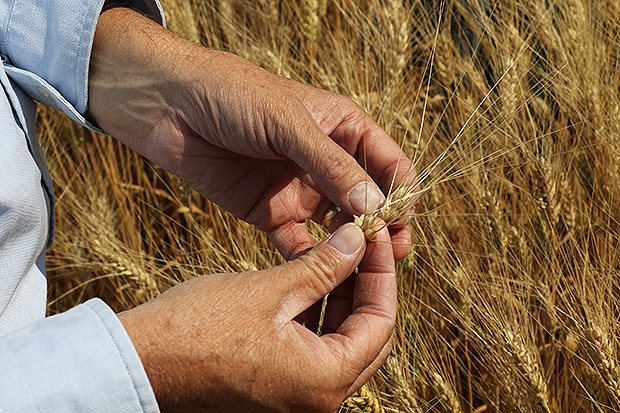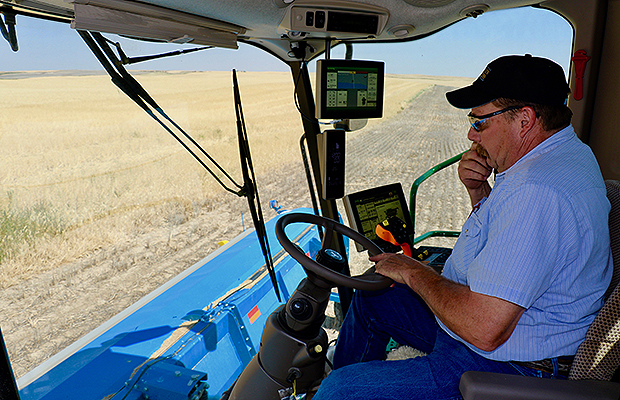“Holy Ground” Found on Church’s Arid Montana Wheat Farm
Contributed By Jason Swensen, Church News associate editor

Waist-high durum wheat is ready for harvest at the Geraldine Montana Crops welfare farm. Photo by Jason Swensen.
Article Highlights
- The 5,000-acre Geraldine Montana Crops Church welfare farm provides almost all of the grain used to make spaghetti, macaroni, and other pasta for people in need.
“Our number one job is to provide for the needy. What we are doing here goes far beyond the membership of the Church. We’re helping feed people worldwide.” —Bill Summer, farm manager
GERALDINE, MONTANA
Try forming a quick list of holy spaces in your mind.
The temple is likely at the top of the “holy space” list, followed, perhaps, by a quiet burial ground, a dedicated meetinghouse, or maybe a quiet corner of one’s home reserved for prayer and scripture study.
Now add the Geraldine Montana Crops (GMC) welfare farm to the list.
The Church-owned 5,000-acre stretch of farmland on the edge of Montana’s fertile Golden Triangle looks and feels a bit different from other holy places. It can be blast-furnace hot or teeth-chattering cold—often in the same week. It’s usually dry. It’s often dusty. And it’s undeniably sacred.
The farmers who work GMC say the Lord’s hand is traced in each kernel of protein-rich durum wheat harvested here each summer. “Our number one job is to provide for the needy,” said farm manager Bill Summer. “What we are doing here goes far beyond the membership of the Church. We’re helping feed people worldwide.”

The durum wheat grown at the Church’s Geraldine Montana Crops welfare farm will later be milled into the protein-rich flour used to make pasta at the Deseret Mill and Pasta Plant in Kaysville, Utah. Photo by Jason Swensen.
White and ready to harvest
As an agricultural specialist for The Church of Jesus Christ of Latter-day Saints, Wade Sperry spends much of his time taking stock of crops raised on welfare agricultural properties. One day he might be slicing open a peach picked from the Church orchard in Brigham City, Utah. A few days later, he’s inspecting the Church-produced peanut crop in south Texas or perhaps swapping notes with missionary-cowboys herding cattle in Taylor, Arizona.
And each year he travels to Geraldine.

Rustic wagon wheel sign welcomes visitors to the Church-owned Geraldine Montana Crops welfare farm in northwest Montana. Photo by Jason Swensen.
The work being performed here along this vast stretch of plains is essential to the Church’s welfare food program. The GMC welfare farm provides almost all of the grain used at the Deseret Mill and Pasta Plant in Kaysville, Utah. The spaghetti, macaroni, and other nutrient-rich pasta produced at the towering facility off Interstate 15 typically began as durum wheat in northwestern Montana.
“This farm provides wheat for the pasta that’s made available for bishops to help those in need of assistance,” said Sperry. “It is sacred ground. Through this farm, the Lord pays attention to the poor and needy.”

Flour from the protein-rich durum wheat raised on the Geraldine Montana Crops farm is used to produce most of the pasta manufactured at the Deseret Mill and Pasta Plant in Kaysville, Utah. Photo by Jason Swensen.
President Eldon Pfile presides over the Great Falls Montana East Stake, which functions as the agent stake for the GMC welfare farm. Each year, members of all ages from his stake donate essential volunteer hours to ensure a bumper crop. The farming pros such as Bill Summer operate the massive John Deere combines that seed, fertilize, and eventually harvest the wheat crop. But volunteers are enlisted to clear rocks, remove trees, and clean storage sheds.
“We come here to volunteer temporally, but we leave spiritually uplifted,” said President Pfile.
Some of the youth volunteers are not accustomed to farm life. They are fascinated by the seemingly endless stretches of dirt road encircling the Church property. They lament the spotty cell phone coverage. “But whenever they work out on the Church farm they come to me and say, ‘The Spirit here is so strong,’” said Summer.

Latter-day Saint youth and their advisers from the Great Falls, Montana, area frequently volunteer at the Geraldine Montana Crops welfare farm. Photo courtesy of Bill Summer.
For farmers and volunteers alike, each year’s durum wheat crop teaches eternal principles, such as the law of the harvest and the law of consecration. “We learn that you reap what you sow,” said President Pfile. “We can [realize] a harvest that blesses us and those we serve.”
Bill Summer repeats a phrase he learned from a fellow farmer who labored on the Church-owned Geraldine property: we go the temple to make our covenants—we go to the farms to keep our covenants.”

Farmer Bill Summer harvests durum wheat on August 14, 2018, on the Church-owned Geraldine Montana Crops welfare farm. Photo by Jason Swensen.
Farming=faith
The Geraldine Montana Crops welfare farm is a dry farm. Irrigation is not an option. So every drop of water consumed by the vast, thirsty wheat crop is counted as a gift from God.
Rain is abundant some years. And other times, the clouds are few. So members here petition heaven through fasting and prayer. “We are on our knees quite often asking for His blessings,” said Summer. “Farming is 100 percent faith.”
Few people who receive manna-like sustenance from a plate of spaghetti or macaroni made from GMC-grown wheat will ever visit this northern Montana farm. But each year’s harvest reminds local Latter-day Saints of the meaning of “pure religion”: to visit the fatherless and widows in their affliction (James 1:27).
Sometimes those reminders are close by, said Summer. A fellow ward member once threw his arms around him after learning he worked at the GMC welfare farm.
“I grew up on Church welfare,” the man told him. “My father left my mother when I was young, and we lived on what the Church gave us.”
“That,” said Summer, fighting back emotion, “really opened my eyes.”

From the cab of a massive John Deere combine, farmer Bill Summer harvests durum wheat on August 14, 2018, at the Church-owned Geraldine Montana Crops welfare farm. Photo by Jason Swensen.

Church agricultural specialist Wade Sperry, left, and Great Falls Montana East Stake President Eldon Pfile inspect wheat at the Geraldine Montana Crops welfare farm. Photo by Jason Swensen.

From left, President Eldon Pfile, farmer Bill Summer, and Church agricultural specialist Wade Sperry discuss the 2018 durum wheat harvest at the Geraldine Montana Crops welfare farm. Photo by Jason Swensen.

Grain bins at the Geraldine Montana Crops welfare farm store tons of durum wheat that will eventually be used to make pasta products to be sold at Church-operated bishops’ storehouses. Photo by Jason Swensen.

Spaghetti produced at the Deseret Mill and Pasta Plant was made from durum wheat harvested at the Geraldine Montana Crops welfare farm. Photo by Chelsey Allder.
